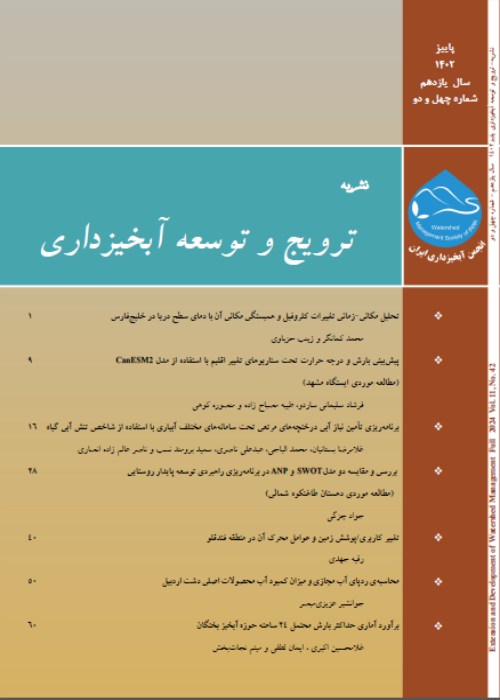Evaluation of Seasonal Changes of Tajan River Water Quality using Simulation Model of Qual2kw
Article Type:
Research/Original Article (دارای رتبه معتبر)
Abstract:
Access to fresh and quality water is one of the most important issues for humans today. Having healthy water resources is an essential prerequisite for maintaining environmental quality and economic, political, social and cultural development. Increasing population and urban, agricultural and industrial development of the country further highlights the importance of paying attention to the quality of available water resources. With increasing of demand for water supplies and continued pollution of rivers and other waters, this will become a growing crisis in the future. Surface waters or rivers are the most important water resources that play an important role in supplying the water needed for various activities such as agriculture, industry, drinking and power generation. Today, using a simulation model is a common approach to water quality monitoring along the river's path. In this research, the water quality of Tajan River in Mazandaran province was evaluated, which is considered as one of the most important sources of water supply in different parts of the province. Using qualitative numerical simulation model (Qual2kw), investigated the process of changing the parameters of water quality parameters such as dissolved oxygen (DO), biological oxygenation (BOD), acidity (pH), electrical conductivity (EC), nitrate (NO3-) and phosphate (PO43-). The average monthly data from 1385 to 1395 was entered into the model at three stations of the water regional company and environmental office along the river. Calibration of the model was performed based on the low water season data (September) and validation of the model was based on the high season data (December and February). The results of the Tajan River simulation showed that the Qual2kw model provides an appropriate estimation of the river quality conditions and this model could simulate the parameters with the appropriate accuracy. The results showed that despite the presence of point and non-point pollutant sources along the Tajan River, there is no limiting factor in supplying drinking water and agriculture at the downstream. In the aspect of agriculture, the water quality is suitable for agriculture in the whole of the river path. Only Kordkhil station was good category due to located in the downstream of the river and the rest of the stations are in the excellent category, which can be used for agriculture. The maximum self-purification power was belonging to the interval 2 (between Pol-e-Tajan and Kordkhil) equal to 7485.346 tons per day and the minimum of self-purification power was belonging to the interval (1) (between Rig-Cheshmeh and the Pol-e-Tajan) equal to 102.6805 tons per day. This trend shows that the power of self-purification of the river was increased from upstream to downstream.
Keywords:
Language:
Persian
Published:
Journal of Extension and Development of Watershed Managment, Volume:10 Issue: 36, 2022
Pages:
48 to 59
magiran.com/p2489328
دانلود و مطالعه متن این مقاله با یکی از روشهای زیر امکان پذیر است:
اشتراک شخصی
با عضویت و پرداخت آنلاین حق اشتراک یکساله به مبلغ 1,390,000ريال میتوانید 70 عنوان مطلب دانلود کنید!
اشتراک سازمانی
به کتابخانه دانشگاه یا محل کار خود پیشنهاد کنید تا اشتراک سازمانی این پایگاه را برای دسترسی نامحدود همه کاربران به متن مطالب تهیه نمایند!
توجه!
- حق عضویت دریافتی صرف حمایت از نشریات عضو و نگهداری، تکمیل و توسعه مگیران میشود.
- پرداخت حق اشتراک و دانلود مقالات اجازه بازنشر آن در سایر رسانههای چاپی و دیجیتال را به کاربر نمیدهد.
In order to view content subscription is required
Personal subscription
Subscribe magiran.com for 70 € euros via PayPal and download 70 articles during a year.
Organization subscription
Please contact us to subscribe your university or library for unlimited access!


